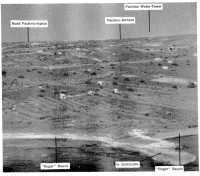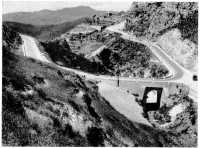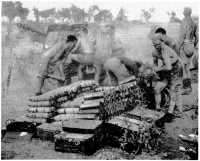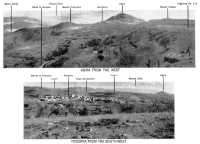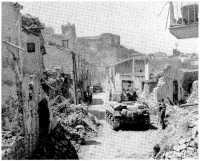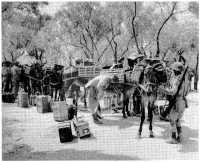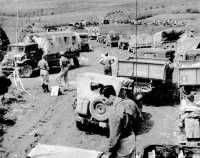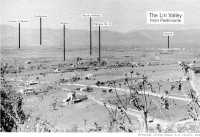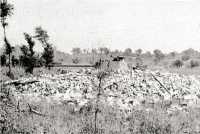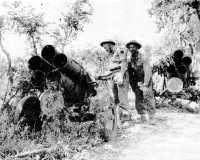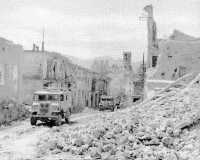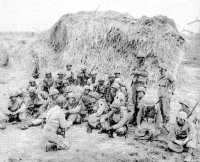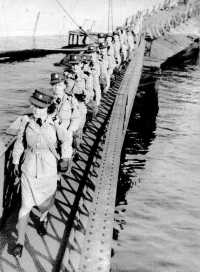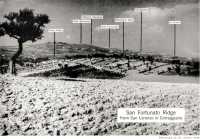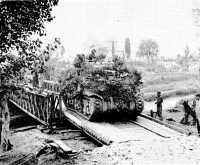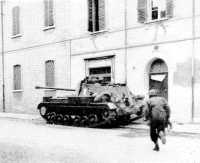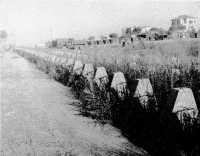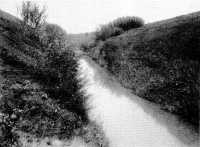Illustrations
Off to Sicily
Men of the Saskatoon Light Infantry, support battalion of the 1st Canadian Division, board their transport at Glasgow, June 1943.
The Pacino Beaches
From an aerial reconnaissance photograp taken before the landings.
The approach to Leonforte
Photograph courtesy Larry Henderson, 1950. This is the route by which a company of the Princess Patricia’s Canadian Light infantry, supported by tanks and anti-tank guns, swept into the town on the morning of 22 July 1943. The bridge shown here replaces a temporary structure built by the 3rd Field Company RCE during the night before the attack.
Canadian Artillery in Sicily
Gunners of the 7th Battery, 2nd Field Regiment RCA, firing in support of the 2nd Infantry Brigade’s operations at Nissoria. This photograph was taken on 28 July, the day on which the town fell.
These photographs, taken in 1948, illustrate the hilly terrain over which the 1st Canadian Division fought during the last week of July 1943
The Ruins of Regalbuto. Tanks of the Three Rivers Regiment, in support of the 1st Canadian Division, rumble through the devastated town shortly after its capture on 2 August 1943
A mule train in Sicily. The Edmonton Regiment prepares for a cross-country move through the mountains towards Point 736, captured on 5 August 1943
Canadian troops relieve Indians in the Liri Valley. The Carleton and York Regiment relieves a unit of the 8th Indian Division north of Pignataro, 16 May 1944.
Supplies to the front. A long supply column moves westward from the junction of the Liri River with the Gari, 21 May 1944. The vehicles are those of the Eighth Army and 1st Canadian Corps Troops.
The Liri Valley from Piedimonte
A German anti-tank position in the Hitler Line. This long 75-mm. anti-tank gun mounted on a panther turret beside the Aquino–Pontecorvo road was knocked out in the assault on the Hitler line on 23 May 1944
Canadian Gunners view a German weapon. This photograph, taken on 24 May 1944, shows two members of the 4th Anti-Tank Regiment examining a “Moaning Minnie” (Nebelwerfer) captured the day before in the Hitler line.
Pontecorvo, 24 May 1944. Canadian transport moves through the heavily damaged town the day after its capture by the Royal Canadian Regiment.
Patrol in blackface on the Anzio beachhead. Briefing a patrol of the Canadian-US First Special Service Force, 27 April 1944. Some of the patrol, including the briefing officer, are members of the 1st Canadian Special Service Battalion.
Arrival of CWAC in Italy. Members of the Canadian Women’s Army Corps disembark at Naples, 22 June 1944. Some of these girls were employed at First Echelon, in Rome; others joined the Army Show.
San Fortunato Ridge from San Lorenzo in Correggiano
?Canadian armour at the Uso. The first Canadian tank to cross the Uso River at San Vito, 26 September 1944. It is a Sherman of Lord Strathcona’s Horse (Royal Canadians), supporting the 4th Princess Louise Dragoon Guards.
Action at Cesena, 20 October 1944. Crossing the street under enemy fire is a soldier of The Carleton and York Regiment. The self-propelled gun is a 17-pounder of the 1st Canadian Anti-Tank Regiment.
German anti-tank defences along the Adriatic. Concrete “dragon’s teeth”, designed to protect Cesenatico against amphibious or seaborne tanks. Their effectiveness was not tested: for the Germans withdrew and The Governor General’s Horse Guards entered the town unopposed on 20 October 1944—by land.
The Lamone river looking downstream (north-eastward) at the site of The Hastings and Prince Edward Regiment’s crossing (right to left) on 5 December 1944. The flood banks rise 40 feet above the river level.

